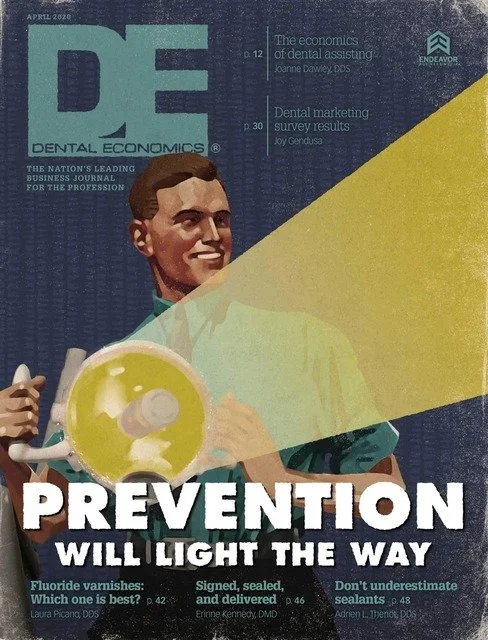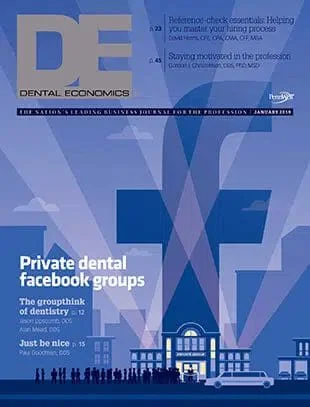Publications
Dr. Scott H. Froum is a nationally recognized periodontist in New York City and the editorial director of The Perio-Implant Advisory. He is a contributing author to two textbooks on dental implant complications and serves on the advisory board of Dental Economics Magazine. His work frequently explores topics such as gum disease treatment, implant failure, tissue regeneration, and surgical complication management.
As a board-certified periodontist and implantologist in Midtown Manhattan, Dr. Froum brings both academic insight and hands-on surgical experience to his writing. His published research helps guide general dentists, specialists, and surgeons in delivering more predictable outcomes in complex periodontal and implant cases.
Recent Publications
-

Halitosis: It's more than just oral hygiene
-

Reducing the need for adjunctive antibiotics during scaling and root planing
-

A minimally invasive recipe for esthetic success
-

Implant Complications: “My dental implant fell out!”
-

Dental implants fail at a rate 10 times that of natural teeth in patients with treated chronic periodontitis: New Study
-

Dentistry is completely safe with enhanced infection control
-

Can periodontal disease be a contributing factor for Covid-19 severity
-

Vitamin D deficiency: Impact on wound healing and implant failure
-

Dental implant contamination: 3 reasons behind a late-stage failure
-

Antibiotic prophylaxis for patients with breast implants prior to dental procedures
-

Lasers in dentistry: Hard-tissue applications
-

Saving teeth: Changing the hopeless prognosis with new technology
-

The new classification of periodontal disease that you, your patient, and your insurance company can understand
-

The difficult task of competing with discount implant centers
-

Dental Implant Complications: Etiology, Prevention, and Treatment, 2nd Edition
-

Implant Complications: Multiple Treatment Modalities; Few Financial Options
-

Dollars and Sense: Saving Teeth vs. Placing Implants
Recent Articles
-
“Are You Using Too Much Toothpaste? Here’s Exactly Why It Matters”
-
“Should You See a Doctor During the Pandemic?”
-
“Incidence of COVID-19 Virus Transmission in Three Dental Offices: A 6-Month Retrospective Study”
Perio-Implant Advisory Recent Articles
-
Type 5 diabetes (severe insulin-deficient diabetes): What every dental professional should know
-
Microplastics detoxification support for your body
-
Dry socket prevention with an oral hydrogel wound dressing
-
Microplastics in chewing gum and practical ways to reduce exposure
-
What is methylene blue?
-
Loss of taste and increase in mortality risk
-
Changes in the oral microbiome associated with mental health
-
Dry socket prevention with the Polyox bandage
-
Probiotics vs. antibiotics for post-dental surgery
-
Poor diet decisions? Blame your genetics
-
Aluminum named allergen of the year and dental restorations can contain aluminum: Explaining this to your patient
-
Peri-implant disease: Using artificial intelligence to predict those at risk
-
Gum bleeding after a dental cleaning
-
The dangers of hand sanitizer use and misuse
-
Implant malposition: A simple clinical technique for prevention
-
Avoiding dental implants and the sinus lift procedure: Revisiting maxillary molar root amputation
-
Olfactory training and COVID-19-related loss of smell
-
COVID-19 immunological memory may last longer than previously anticipated
-
Top 5 oral manifestations of COVID-19
-
Lowering the transmission and spread of human coronavirus with over-the-counter products
-
How does COVID-19 affect salivary flow and xerostomia?
-
Sjögren’s syndrome: Considerations during and after cosmetic dentistry
-
Loss of smell and taste: Distinguishing between COVID-19 and the common cold/flu
-
Vitamin D deficiency and COVID-19
-
CDC Revises Guidance on Isolation After COVID-19 Positive Test
-
Saving Teeth Versus Placing Implants, a Cost Analysis
-
Salivary Diagnostics for COVID-19 Prove as Reliable as Nasopharyngeal Swab in New Study
-
Decontaminating N-95 Respirator Mask After COVID-19 Exposure
-
How Does COVID-19 Affect Salivary Flow and Xerostomia
-
Sjgrens Syndrome Considerations During and Afte Cosmetic Dentistry
-
How one dentist in NYC is making his dental office a safe place post–COVID-19
-
Vitamin D and COVID-19 disease severity: An old ally in a new war
-
The importance of periodontal treatment in post–COVID-19 dentistry
-
Can periodontal disease be a contributing factor for COVID-19 severity?
-
COVID-19: Flattening the curve—the best offense is a good defense
-
Do NSAIDs exacerbate coronavirus severity: Myth or reality?
-
COVID-19 and the problem with dental aerosols
-
Saving teeth: Revisiting molar furcation treatment with advanced technology
-
The dental specialist: How do we establish brand awareness among our patients?
-
Dental implant failure: 3 common medical conditions that may affect success rates
-
Vitamin D deficiency: Impact on wound healing and implant failure
-
Failing dental implants: Ascertaining the etiology behind a sudden increase
-
Video: Extraction and socket grafting in preparation for implant placement
-
Top 10 motivational oral hygiene analogies
-
Saving teeth: Revisiting molar furcation treatment with advanced technology
-
The dental specialist: How do we establish brand awareness among our patients?
-
Bone grafting after tooth removal: Why, when, and what to use
-
Antibiotic prophylaxis for patients with breast implants prior to dental procedures
-
A review of available periodontal surgical techniques for pocket elimination
-
Fractured dental implant screw complications: 3 methods for screw retrieval
-
Dental pain: Predicting postoperative pain prior to the procedure
-
Do root canals cause cancer?
-
Vaping and Oral Health: It’s worse than you think
-
5 of the Most Common Questions Dental Patients Ask and How to Answer Them
-
Saving Teeth: Changing the Hopeless Prognosis with New Technology
-
The new classification of periodontal disease that you, your patient, and your insurance company can understand
-
Canker Sores: An Old Enemy Facing New Treatment
-
Saving T-I-M-E with Short Dental Implants
-
Top Causes of Gingival Enlargement and Treatment Options
-
Are We There Yet? A New Instrument that Determines when Dental Implants are Ready to be Restored
-
5 Questions to Ask When Determining if Teeth with Perio-Endo Infections Can Be Saved
-
Lies, Damned Lies, and Statistics: The Truth Behind the Importance of Flossing
-
Alternative to Suturing Reduces Surgical Time for Dental Procedures
-
Functional Crown Lengthening Around Bleeding Crown and Veneer Restorations
-
Top 5 Sources of Dental Implant Pain When ‘There is Nothing Wrong with the Implant'
-
Top Factors Leading to Dental Implant Abutment/Implant Fixture Misfit: The Dreaded Macrogap
-
5 Pathologies Most Likely to Affect the Tongue: Importance of Proper Examination and Diagnosis
-
Saving Teeth: They Must Not Teach That as the First Therapeutic Response in Dental School
-
Top 5 Anatomical Differences between Dental Implants and Teeth that Influence Treatment Outcomes
-
Pinhole Surgical Technique: The Rebirth of the Noninvasive Soft-Tissue Graft
-
Facts and Figures Behind the Opioid Epidemic: 3 Clinical Methods to Alleviate Pain and Decrease the Need for Opiates
-
Alternative to Suturing Reduces Surgical Time for Dental Procedures
-
The Best Bad-Breath Remedies, According to Dentists” -nymag.com article featuring Dr. Scott Froum
-
Replacement dental implants: 3 clinical methods to increase survival rates after initial implant failure
-
Implant-induced decay: A problem bigger than you think
-
5 seconds of implant safety that can save 5 years of litigation

